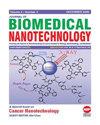A Simvastatin-Loaded Nanoliposome Delivery System for Sepsis-Induced Acute Lung Injury
IF 2.9
4区 医学
Q1 Medicine
引用次数: 0
Abstract
To enhance the treatment of acute lung injury (ALI) induced by sepsis and optimize the clinical efficacy of simvastatin (SV), we develop SV-loaded nanoliposomes (SV/NLC) as a novel drug delivery system. The NLCs exhibited a particle size of approximately 165 nm, which increased to around 195 nm upon SV loading. NLCs significantly prolonged the half-life of SV by nearly five-fold and improved its penetration into EA.hy926 cells, demonstrating excellent biocompatibility and targeted delivery for ALI therapy. In the rat model of ALI, the SV/NLC effectively reduced the lung wet/dry ratio and the levels of inflammatory factor and albumin in the alveoli, thus improving the alveolar gas exchange function and blood oxygenation. The SV/NLC group demonstrated superior suppression of oxidative stress within lung tissues compared to other groups. Notably, treatment with SV reduction in TLR4, MyD88, and NF-κB P65 levels in lung tissues from ALI rat models. This effect was particularly pronounced in the SV/NLC group. Furthermore, SV can effectively mitigate inflammatory responses and oxidative stress in ALI treatment by modulating the TLR4/NF-κB signaling pathway. In conclusion, our findings suggest that SV can exert therapeutic effects against sepsis-induced ALI through inhibition of the TLR4/NF-κ and mitigate inflammatory response and oxidative stress.治疗脓毒症诱发的急性肺损伤的辛伐他汀载体纳米脂质体输送系统
为了加强对脓毒症诱发的急性肺损伤(ALI)的治疗并优化辛伐他汀(SV)的临床疗效,我们开发了一种新型给药系统--SV负载纳米脂质体(SV/NLC)。纳米脂质体的粒径约为 165 nm,载入 SV 后粒径增至约 195 nm。NLCs 将 SV 的半衰期延长了近五倍,并提高了 SV 在 EA.hy926 细胞中的穿透力,证明了其在 ALI 治疗中出色的生物相容性和靶向递送能力。在大鼠 ALI 模型中,SV/NLC 有效降低了肺干湿比以及肺泡中的炎症因子和白蛋白水平,从而改善了肺泡气体交换功能和血氧饱和度。与其他组相比,SV/NLC 组能更好地抑制肺组织内的氧化应激。值得注意的是,SV 治疗降低了 ALI 大鼠肺组织中 TLR4、MyD88 和 NF-κB P65 的水平。这种效应在 SV/NLC 组中尤为明显。此外,SV 还能通过调节 TLR4/NF-κB 信号通路,有效缓解 ALI 治疗过程中的炎症反应和氧化应激。总之,我们的研究结果表明,SV 可通过抑制 TLR4/NF-κ 发挥治疗脓毒症诱发的 ALI 的作用,并减轻炎症反应和氧化应激。
本文章由计算机程序翻译,如有差异,请以英文原文为准。
求助全文
约1分钟内获得全文
求助全文
来源期刊
CiteScore
4.30
自引率
17.20%
发文量
145
审稿时长
2.3 months
期刊介绍:
Information not localized

 求助内容:
求助内容: 应助结果提醒方式:
应助结果提醒方式:


